Perennial shade-loving plants for the garden

In any garden there are always areas where the sun's rays infrequently penetrate, and this cannot but upset flower growers, because most ornamental crops prefer well-lit areas. But do not be upset - even the most shady garden can always be decorated with beautiful shade-loving perennials. Of course, they do not give long flowering, but they have a spectacular appearance.


Peculiarities
When choosing plants to decorate your garden, one of the key factors is the presence or absence of sunlight throughout the day. Most flower growers think that if the site is shady, then no flowering crops will grow on it, as they will certainly wither away. However, this statement is incorrect because there are many plants, including those for which shade is favorable to maintain quality growth and healthy development.
Such plants can be both annual and perennial, among them there are grasses, shrubs and flowers, they are tall and short - the choice of shade-loving crops for growing in gardens is quite large.
Usually the more tall fruit trees and outbuildings there are in the garden and the higher the fence, the shader the garden plot will be. Shade-tolerant plants tolerate periodic and constant shading and this is their main difference from light-loving crops.



Low illumination has a significant effect on their appearance: as a rule, shade-loving crops have two-sided leaves, while light-loving ones have equilateral leaves; leaf plates are in most cases smooth and large, and in light-loving crops, foliage is often folded, textured. Their root system is superficial, but the rhizome itself is thickened.
Species overview
There are many perennials suitable for growing in shady gardens. They are conventionally divided into shrubs, as well as flowers and herbs. The first ones can have very different heights, most often they are planted in the form of a hedge, but in a single planting they can look very impressive. Flowers and herbs grow up to 15-45 cm and can be used both as a background planting and to create decorative accents of a garden composition.



Shrubs
Astilba
It is a perennial shrub with about 400 varieties. Flowering begins in July and lasts 3-4 weeks. Flowers are collected in paniculate inflorescences, their shades can be very different, but most often gardeners choose varieties with white, purple, red and pink petals.
This culture tolerates shade well, but a short drought and poor soil is dangerous for them, therefore, Astilba needs regular watering (1-2 times a day, depending on the weather) and top dressing.

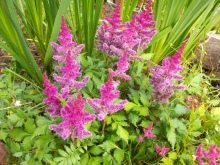

Volzhanka
A beautiful spreading shrub with a large number of inflorescences of a white tone. Flowering occurs in June-July. The height of the bush is 1.5-2 m. Volzhanka can grow in sunny areas and in the shade, but in the light it develops worse and does not give lush flowering.
The culture is unpretentious, in one place it can grow up to 20 years, without requiring transplantation and feeding.


Geichera
The main advantage of this ornamental plant is its wide tint palette. Its leaves can be painted in a variety of shades - gray, cream, red, as well as purple, brown and white.
Gardeners highly appreciate Heuchera for its unpretentiousness - the bush looks spectacular from early spring to late autumn, and a pleasant bonus is its unpretentiousness, resistance to diseases and attacks of garden pests.



Hydrangea
Gardeners love shade-tolerant perennial hydrangeas for their beautiful and long flowering, which begins in late spring, lasts all summer and ends in late autumn. The personal plot on which this culture grows invariably attracts the attention of the surrounding blooming balls., as well as the shade range of inflorescences (they can be white, beige, pink, red and even blue). The shade of large-leaved hydrangea depends not only on its varietal characteristics - it can change depending on the presence of aluminum in the soil and the level of acidity of the substrate.
Garden hydrangeas reach a height of 1-3 m, lianas grow up to 30 m. Depending on the variety, the plant can be deciduous or evergreen.
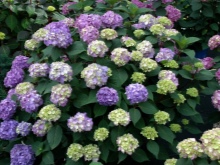


Japanese maple
This plant is a type of deciduous tree that is often grown and used in landscaping. The homeland of the shrub is the Land of the Rising Sun, it can also be found in South Korea. Nowadays, breeders have bred a lot of varieties of this culture, the height of which does not exceed 2 m. Japanese maple is highly valued for its low growth rate and decorative appearance. Its leaves from mid-spring to the deepest autumn remain rich green, and in the fall they acquire dark red and purple-brown tints.
It is better to plant the plant in full shade, since burns appear on its leaves with a large amount of light.



Flowers
Astilba
A perennial flowering plant in which the ground part dies off in the winter. Astilba feels good in the shade and prefers wet soils. There are over 40 varieties of this plant with a height of 10 cm. Paniculate inflorescences have a variety of colors, pink, red, purple and white varieties look most impressive.
In dry times, plants should be watered in the morning and evening - poor soil, scorching sun and prolonged drought can destroy this crop very quickly.



Coleus
It is one of the most popular perennials: it grows quickly, looks very beautiful and is practically not affected by garden pests. Coleus easily adapt to any type of soil, but prefers shade and light partial shade, requires abundant watering.
Coleus is grown not because of its flowering, but for the beauty of the leaves, which can have a wide variety of shades: yellow, lemon, brown, pink, as well as all kinds of their undertones. Some varieties are even multi-colored, for example, in the center the leaf plate is purple-red, and at the edges it is yellow. It is noteworthy that when small bluish leaves appear on the coleus, they are simply cut off, since they spoil the whole impression of the plant.
Coleus is not able to tolerate frost, the optimal temperature for them is considered to be a level of at least 10 degrees. That is why most often the plant is planted in pots, and with the onset of low temperatures, it is brought into the room. In the spring, when the threat of recurrent frosts has passed, they are returned back to the garden.

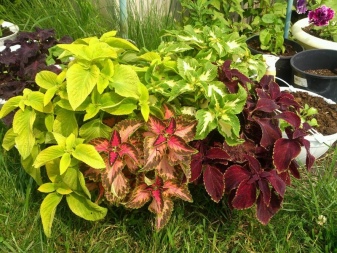
Forget-me-not
The simplest, but at the same time, effective solution to decorate your land will be the planting of forget-me-nots. These shade-tolerant flowers require virtually no maintenance, you just need to keep the soil moist. Forget-me-not bloom begins in May and ends at the end of June. The diameter of the flowers does not exceed 1 cm, the petals are blue, and the middle is yellow, similar to the sun. This color combination gives the plant real tenderness and natural charm.
Forget-me-nots are often planted under fruit trees and around shrubs, where they create a spectacular carpet that can add flavor to any landscape design.
Almost all varieties of forget-me-nots grow in the shade, the only exception is Alpine, which requires sunny areas for growth.
There is an interesting legend explaining the name of the flower. It says that once a young girl with her lover walked along the banks of the Danube River and saw a beautiful blue flower in its waves. The young man took it out, but could not get out. Dying, he said the words: "Do not forget me."
By the way, it was the forget-me-not that has long been a symbol of German Freemasonry.

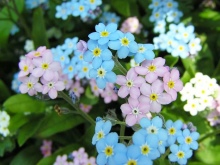
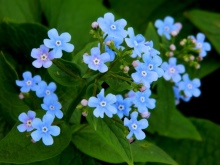
Violets
Another perennial that does not require special care is the violet. Gardeners appreciate it for the beauty of the purple petals that contrast with the deep green leaves. All that a gardener needs to maintain the decorative appearance of a violet is regular watering, as well as periodic application of organic fertilizers to the ground.
In the garden, they grow tricolor, horned and fragrant violets.

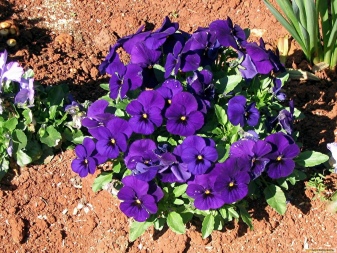
Hosta
Although the hosta is a flowering plant, it is prized by gardeners for its large, fleshy leaves, which can have a wide variety of shades of green, yellow, white and blue. Hosta is a low-growing crop, its height does not exceed 20-30 cm, so it often seems that the leaves seem to grow immediately from the soil.
A perennial is unpretentious, caring for it is very simple - you need to provide it with a sufficient amount of water. If the land where the hosta grows dries up, then the plant withers and quickly dies. Despite the fact that the hosta prefers shady areas, it is still advisable to plant it in a place where the rays of the sun will fall on it in the morning.


Irises
Speaking of persistent perennials, one cannot fail to mention irises. This plant has several hundred varieties that grow both in the natural environment and genetically bred hybrids. Irises are popular due to their bright bloom, which is not surprising, because the name itself "Iris" in Latin means "rainbow"... Iris blooms can be orange, red, blue and many other shades.
Irises do not require special care, but you should know some rules for caring for them. So, it is desirable to plant them with bulbs, and this should be done either in early spring or late autumn. They need regular watering. Particular attention should be paid to the soil - it must have good drainage properties and an average level of fertility.
Despite the fact that this plant belongs to shade-resistant, it is better to grow it in such an area where the sun still shines on it in the morning. In regions with severe winter temperatures at the end of autumn, cover the irises with mulch or agrofibre to protect the bulbs from freezing.


How to choose?
When determining the basic parameters of light-requiring, usually are guided by the following definitions:
- shadow - in this case, sunlight hits the site for 2-3 hours a day;
- liquefied shadow - these are areas under the crown of spreading trees, in such conditions the vast majority of garden flowers grow and develop successfully;
- penumbra - rays of light illuminate such areas for 3-4 hours a day, usually in the morning or evening;
- deep shadow - plots near fences, as well as houses and buildings, light does not get here at all, which is suitable for growing a very small number of plants.


Depending on this classification, plants are distinguished, intended for flower beds, growing in the shade of trees or near high fences. Pay attention to the side of the world. For example, if you plan to plant plants from the north side, where there is no direct sunlight and at the same time there is high humidity, the best solution would be to plant hosts, geraniums or ferns.
For shaded areas of the garden, the specifics of the culture itself should also be taken into account. So, privet and laurel are not recommended to be planted in gardens, since no other flowers will simply grow next to them. This is due to the fact that they secrete special substances that stop the growth of all living things nearby.


Care Tips
Most shade-tolerant species are naturally resistant to disease and pest attacks. They can withstand temperature fluctuations, but they are moisture-loving and require good moisture. They especially need watering in late spring, when hot weather sets in. These plants need to be watered several times a day without waiting for them to wilt. In doing so, keep in mind that water should not form puddles on the surface of the earth. Areas with a high groundwater table, as well as lowlands and poorly drained areas are not suitable for planting.
Shade-loving perennials require regular feeding and fertilization: it is best to use organic compounds or complex mineral preparations designed for specific crops. It is very important to provide air flow to the roots. To do this, the soil must be constantly loosened and weeds removed. In this case, all plants in a shady garden will be able to better absorb water and receive adequate nutrition.


Examples in landscape design
Shade-loving plants are usually collected in a wide variety of flower beds. Multilevel plantings, as well as island-type flower beds, are very popular. When growing shrubs and flowers in the shade, one should adhere to the scheme: no more than 10 ground cover bushes, 5 medium-sized, 7 low-growing and 3 tall plants can grow on one square meter - only in this case the composition will look harmonious, and the shrubs themselves will feel good.




Curly perennials look very impressive in the country.


Ornamental shrubs are in no way inferior to them in beauty.



Plants that love shade are very popular with gardeners. - they enliven the dark and gloomy parts of the garden, while delighting their owners with bright colors for many years, while requiring almost no maintenance.
An overview of perennial shade-loving plants for the garden in the video.







































































































The comment was sent successfully.